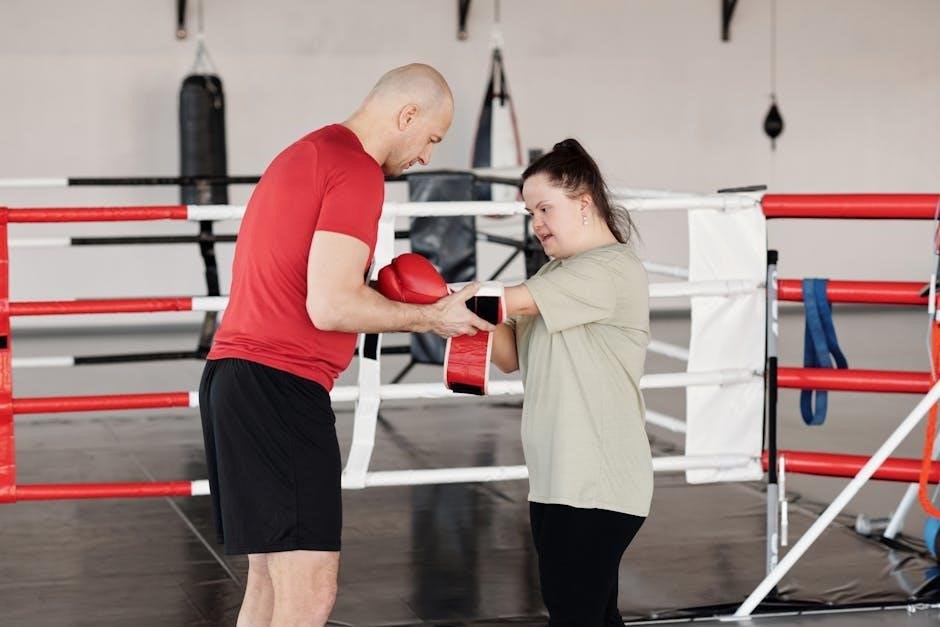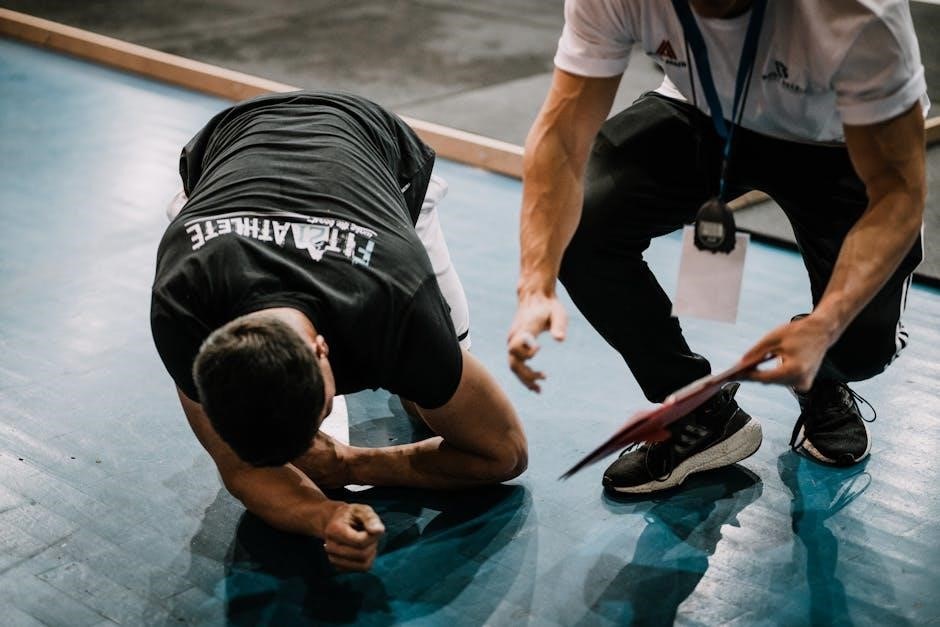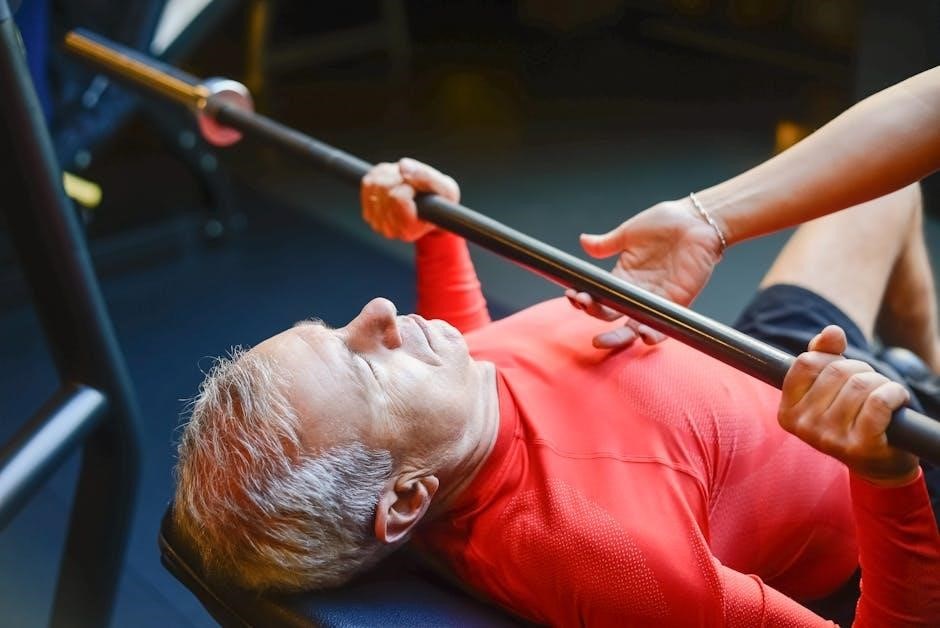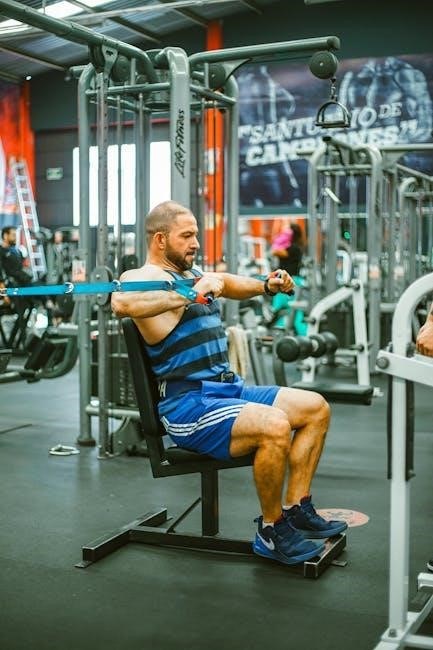A well-structured baseball workout program is essential for improving performance, preventing injuries, and building endurance․ It combines strength, speed, and sport-specific exercises tailored to individual needs, ensuring players achieve peak conditioning and longevity in the sport while staying motivated and injury-free․
1․1 Importance of Structured Training

Structured training is crucial for baseball players as it ensures consistent progress and reduces injury risks․ A well-designed program helps build foundational strength, enhance power, and improve agility, all of which are vital for peak performance․ By following a structured plan, players can maintain consistency, avoid overtraining, and focus on specific skills like batting, pitching, or fielding․ This approach also promotes accountability and motivation, as clear goals and routines guide the athlete․ Additionally, structured training allows for better tracking of progress and necessary adjustments, ensuring optimal results․ Whether during the off-season or in-season, a structured program is essential for achieving and sustaining success in baseball․
1․2 Benefits of a PDF Guide
A baseball workout program PDF provides a comprehensive, portable, and easily accessible resource for players․ It allows for structured training plans, customizable routines, and clear progress tracking․ The guide ensures consistency, helping athletes stay on track with their goals․ PDF formats are convenient for sharing with coaches or teammates and can be accessed anytime, anywhere․ They often include expert-approved exercises, nutrition tips, and recovery strategies, making them a valuable tool for optimizing performance․ Additionally, PDF guides are cost-effective and eliminate the need for physical materials, offering a sustainable solution for athletes seeking to enhance their skills and overall fitness․

Understanding the Off-Season Phase
The off-season phase focuses on building foundational strength, enhancing power, and improving overall athleticism․ It sets the stage for peak performance in the upcoming baseball season․

2․1 Building Foundational Strength
Building foundational strength during the off-season is crucial for baseball players to enhance overall performance and durability․ This phase focuses on developing muscle endurance and power through a combination of lower and upper body exercises․ Key workouts include squats, deadlifts, and bench presses, which target major muscle groups․ Core strengthening exercises like planks and Russian twists are also essential for stability and rotational power․ Additionally, conditioning drills such as sprints and agility ladder work improve speed and explosiveness․ Proper form and safety are prioritized to prevent injuries․ Gradually increasing weights and reps ensures progressive overload, helping players build a solid base for more advanced training․ This foundational strength is vital for maintaining performance throughout the season and supporting sport-specific skills like hitting and pitching․
2․2 Incorporating Power Development
Incorporating power development into a baseball workout program is essential for enhancing explosive movements on the field․ This phase focuses on exercises that improve muscular power, enabling players to generate more force quickly․ Plyometric drills, such as box jumps and medicine ball throws, are effective for building explosive strength․ Weighted bat swings and resistance band work also contribute to increased bat speed and throwing velocity․ Power development is crucial for hitters to drive the ball farther and for pitchers to increase fastball speed․ These exercises are typically introduced after building foundational strength, ensuring athletes have the stability and endurance to handle high-intensity training․ Proper form and progression are emphasized to maximize results while minimizing injury risk․ By integrating power-focused workouts, players can elevate their performance and gain a competitive edge during the season․
2․3 Sport-Specific Exercises
Sport-specific exercises are a cornerstone of effective baseball workout programs, designed to replicate game-like scenarios and enhance baseball-related skills․ These exercises focus on improving batting, fielding, and pitching mechanics while increasing explosiveness and reaction time․ For hitters, batting practice with weighted bats and tee work are common, aiming to boost bat speed and power․ Fielders engage in drills like ground ball repetitions and fly ball tracking to sharpen agility and accuracy․ Pitchers benefit from bullpen sessions and throwing drills to refine control and velocity․ Agility ladder drills and shuttle runs are also incorporated to mimic the quick movements required on the field․ These exercises are tailored to each player’s position and role, ensuring they develop the specific skills needed for success․ Proper form and technique are emphasized to prevent injuries and maximize performance gains․

In-Season Training Strategies
In-season training focuses on maintaining strength, preventing injuries, and enhancing agility while balancing game demands․ It includes speed drills, injury prevention techniques, and agility exercises to sustain peak performance․
3․1 Maintaining Strength Levels
Maintaining strength during the baseball season is crucial to sustain performance and prevent decline․ A well-structured in-season program focuses on light resistance exercises, such as upper and lower body workouts, to preserve muscle mass without overtraining․ Emphasizing proper form and avoiding red-flag exercises helps minimize injury risks․ Players should incorporate strength sessions 2-3 times a week, balancing intensity with recovery․ Nutrition plays a key role, ensuring adequate protein intake to support muscle repair․ Hydration and sleep are also vital for maintaining strength levels․ Consistency is key; even moderate strength work can prevent significant loss of power and endurance․ This approach ensures athletes remain robust and resilient throughout the season, avoiding common pitfalls like weight loss and fatigue․ A structured plan keeps players at peak readiness, supporting their overall performance on the field․
3․2 Injury Prevention Techniques
Injury prevention is a cornerstone of effective in-season training for baseball players․ Incorporating dynamic stretching and mobility exercises helps maintain flexibility and reduce muscle tightness․ Strengthening key areas like the shoulders, elbows, and core is essential to withstand repetitive motions common in baseball․ Throwing programs with proper mechanics and pitch counts can prevent arm injuries․ Additionally, balance and stability exercises improve joint health, lowering the risk of sprains and strains․ Monitoring workload and ensuring adequate recovery time are critical․ Many programs also include injury-specific drills, such as exercises to protect the lower back for hitters․ Prioritizing injury prevention techniques ensures players stay healthy, maintain performance, and avoid setbacks during the season․ These strategies are integral to a comprehensive in-season workout plan, fostering long-term durability and success in the sport․
3․3 Agility and Speed Drills
Agility and speed drills are vital for enhancing a baseball player’s quickness and reaction time․ These exercises improve acceleration, deceleration, and directional changes, essential for fielding, base running, and reacting to plays․ Common drills include ladder drills for foot speed, cone exercises for agility, and shuttle runs for multi-directional movement․ Incorporating exercises like the 40-yard dash and pro agility shuttle helps increase linear and lateral speed․ Proper form and technique are emphasized to prevent injuries․ These drills also simulate game-like scenarios, preparing players for real-time decision-making․ By improving agility and speed, players gain a competitive edge, enabling them to cover more ground defensively and round bases more efficiently․ Consistent practice of these drills ensures peak performance during the season․

Post-Season Recovery and Transition
Post-season recovery focuses on active methods like stretching and light exercises to restore player health․ Transition planning ensures a smooth shift to the next season, evaluating past performance for future improvements․
4․1 Active Recovery Methods
Active recovery is crucial for restoring player health post-season․ Techniques include light cardio, stretching, and foam rolling to maintain flexibility and reduce muscle soreness․ Yoga and dynamic stretches improve mobility, while swimming or cycling promote blood flow without excessive strain․ These methods help athletes recover mentally and physically, preventing overtraining and injuries․ Proper hydration and nutrition are emphasized to support the recovery process․ Coaches often incorporate these practices into post-season routines to ensure players return to training refreshed and ready for the next season․ Active recovery not only accelerates healing but also lays the foundation for a strong transition into the next phase of training, keeping athletes in optimal shape․
4․2 Transitioning to the Next Season
Transitioning to the next season requires a strategic approach to ensure players are prepared for the upcoming challenges․ This phase focuses on gradually increasing intensity and specificity in training, allowing athletes to build on their off-season gains․ Coaches often integrate light conditioning and mobility work to maintain fitness without causing burnout․ Players are encouraged to refine their skills through sport-specific drills, such as batting practice, fielding exercises, and pitching mechanics․ The transition period also emphasizes mental preparation, helping athletes set goals and develop a competitive mindset․ Proper nutrition and recovery techniques are highlighted to support the body during this phase․ By the end of the transition, players should feel refreshed, rejuvenated, and ready to perform at their best, setting the stage for a successful season ahead․
4․3 Reviewing Program Effectiveness
Evaluating the success of a baseball workout program is crucial for identifying strengths and areas needing improvement․ Coaches and players should track progress through metrics such as strength gains, speed improvements, and injury rates․ Feedback sessions allow for open communication about what worked well and what adjustments are necessary․ Reviewing training data helps refine future programs, ensuring they align with team and individual goals․ This process fosters accountability and continuous development, ultimately enhancing performance on the field․ By assessing program effectiveness, teams can optimize their training strategies and maintain a competitive edge throughout the season․

Position-Specific Workouts
Position-specific workouts customize training based on player roles, focusing on hitters’ power, pitchers’ velocity, and fielders’ agility to enhance performance and address role-specific demands effectively․
5․1 Hitters: Power and Bat Speed
Enhancing power and bat speed is crucial for hitters to maximize performance․ A structured program incorporates weighted bat swings, plyometric exercises, and explosive training to improve bat velocity․ Proper form and technique are emphasized to prevent injury․ Additionally, strength training targeting the core, legs, and upper body helps generate more force․ Periodization ensures progressive overload, while dynamic stretches and mobility drills maintain flexibility․ Consistency and dedication are key to achieving measurable improvements in power and bat speed, translating to better performance on the field․ Expert guidance ensures a personalized approach, addressing individual strengths and areas for improvement․ This comprehensive strategy equips hitters with the tools to excel in competitive play․
5․2 Pitchers: Velocity and Endurance
Pitchers require a specialized program to enhance velocity and endurance, ensuring longevity and peak performance․ The program focuses on building shoulder and core strength through exercises like weighted ball throws and resistance band work․ Plyometric training and explosive movements improve power, translating to increased pitch speed․ Endurance is developed through high-intensity interval training and cardio drills, enabling pitchers to maintain performance over innings․ Proper pitching mechanics are prioritized to reduce injury risk, while flexibility and mobility exercises prevent stiffness․ Nutrition and recovery strategies, such as hydration and sleep optimization, support overall health․ A well-structured program ensures pitchers can sustain velocity and endurance throughout the season, contributing to team success․ Consistency and attention to detail are vital for achieving these goals and maintaining elite performance levels․ Each element is tailored to address individual needs and enhance overall pitching effectiveness․
5․3 Fielders: Agility and Reaction
Fielders require a training program that enhances agility and reaction time to excel in defensive roles․ Drills like ladder exercises and cone setups improve footwork and lateral speed, essential for quick movements on the field․ Reaction training, such as box jumps and medicine ball throws, sharpens instincts and first-step explosiveness․ Sport-specific exercises, like rapid ground ball reactions and fly ball tracking, simulate game scenarios to build real-time decision-making․ Strength training focuses on lower body power and core stability to support quick changes of direction․ Incorporating plyometrics and dynamic stretching enhances flexibility and range of motion․ Proper form and injury prevention techniques are emphasized to ensure longevity․ Consistent practice of these drills helps fielders develop the agility and reaction skills needed to outperform opponents and make impactful defensive plays consistently․ This comprehensive approach ensures fielders are well-prepared for the demands of the game․

Nutrition and Recovery
Proper hydration, balanced nutrition, and sufficient sleep are crucial for recovery and performance․ Incorporating injury prevention techniques ensures optimal energy levels and supports muscle repair during training․
6․1 Hydration Strategies
Proper hydration is vital for baseball performance and recovery․ Players should drink water regularly before, during, and after workouts to maintain energy levels and prevent dehydration․ Avoid sugary drinks that can cause energy crashes․ Consuming water-rich foods like fruits and vegetables can also contribute to hydration․ During games, sipping water every 10-15 minutes helps replenish lost fluids․ Electrolyte-rich beverages are recommended for intense or long-duration activities to restore lost salts․ Encourage players to avoid heavy meals close to game time to prevent stomach discomfort․ Staying hydrated supports muscle function, focus, and overall athletic performance, which is crucial for optimal play in baseball․ Proper hydration strategies are essential for maintaining peak physical condition and preventing fatigue during training and competition․
6․2 Balanced Nutrition for Performance
A well-balanced diet is critical for optimizing baseball performance․ Players should focus on consuming lean proteins, complex carbohydrates, and healthy fats to fuel their workouts and games․ Incorporating foods rich in antioxidants and vitamins helps reduce muscle soreness and supports recovery․ Carbohydrates provide energy, while proteins aid in muscle repair and growth․ Healthy fats, such as those found in nuts and avocados, support overall health and hormone production․ Avoiding processed and sugary foods is essential to maintain energy levels and prevent fatigue․ Proper meal timing, such as eating a balanced meal 1-3 hours before a game, ensures sustained energy․ Staying hydrated and fueling with nutrient-dense foods are key to maintaining peak performance on the field․ A balanced diet tailored to individual needs helps players achieve their full potential and supports long-term health․
6․3 Sleep and Recovery Techniques
Sleep and recovery are vital for baseball players to optimize performance and prevent overtraining․ Adequate sleep ensures physical and mental rejuvenation, with 7-9 hours recommended nightly․ Establishing a consistent sleep schedule and creating a sleep-friendly environment enhances quality rest․ Recovery techniques like stretching, foam rolling, and ice baths aid muscle repair․ Hydration and nutrition play roles in recovery, with water and electrolytes replenishing fluids lost during workouts․ Active recovery methods, such as light cardio or yoga, promote blood flow without overexertion․ Prioritizing sleep and recovery helps athletes adapt to training, maintain strength, and sustain performance throughout the season․ Proper recovery strategies prevent injuries and ensure players are ready for the next day’s demands, making them integral to a successful baseball workout program․

Sample Baseball Workout Program PDF
A sample baseball workout program PDF provides structured plans for strength, speed, and agility․ It includes exercises like weighted bat swings and plyometrics, ensuring comprehensive training and progression tracking for optimal performance․
7․1 Where to Find Reliable Programs

Reliable baseball workout programs can be found through trusted sources like HittingPerformanceLab․com, TreadAthletics, and Driveline Baseball․ These platforms offer scientifically-backed plans tailored for different skill levels․ Many high school and college programs also provide downloadable PDF guides designed by experienced coaches․ Additionally, websites like Muscle & Strength and specialized baseball training blogs share comprehensive routines․ Always ensure the program is created by certified professionals and includes clear instructions, progression tracking, and safety guidelines․ Consulting with a strength coach or trainer can also help verify the program’s credibility and effectiveness for specific goals․ Prioritize programs that emphasize proper form, injury prevention, and sport-specific exercises to maximize results safely․
7․2 Creating a Personalized Routine
Creating a personalized baseball workout routine involves tailoring exercises to an individual’s specific needs, goals, and position․ Start by assessing current fitness levels, strengths, and weaknesses․ Set clear, measurable objectives, such as improving power for hitters or enhancing endurance for pitchers․ Incorporate a mix of strength training, speed drills, and sport-specific exercises, adjusting intensity and volume based on the athlete’s role․ Use periodization to alternate between building foundational strength, developing power, and refining sport-specific skills․ Ensure proper warm-ups, cooldowns, and recovery techniques are included to prevent injuries․ Track progress regularly and make adjustments as needed․ Consulting with a certified coach or trainer can help customize the program further, ensuring it aligns with the athlete’s unique requirements and promotes sustainable improvement throughout the season․
7․3 Tracking Progress and Adjustments
Tracking progress in a baseball workout program is crucial for ensuring continuous improvement and staying on track with goals․ Begin by maintaining a detailed log of workouts, recording weights, reps, and performance metrics․ Regularly assess strength, speed, and agility to measure advancements․ Use objective markers, such as bat speed or pitching velocity, to gauge progress․ If plateaus occur, adjust the program by increasing intensity, modifying exercises, or incorporating new drills․ Additionally, monitor recovery and overall health, as overtraining can hinder results․ Adjustments should be data-driven, ensuring the program evolves with the athlete’s needs․ Consistent tracking not only enhances accountability but also helps refine the routine for optimal performance, keeping the athlete motivated and focused on their long-term goals․ Regular reviews ensure the program remains effective and tailored to the athlete’s progress․
7․4 Consulting with Professionals
Consulting with professionals is a vital component of maximizing the effectiveness of a baseball workout program․ Strength and conditioning coaches, physical therapists, and experienced trainers can provide personalized guidance, ensuring exercises are performed safely and effectively․ They can identify areas of improvement and tailor the program to address specific needs, such as increasing bat speed or improving pitching mechanics․ Professionals also offer expertise in injury prevention, helping athletes maintain longevity in the sport․ Additionally, they can review progress and make data-driven adjustments to the program․ By leveraging their knowledge and experience, athletes can achieve faster results and stay competitive․ Regular consultations ensure the program remains aligned with the athlete’s goals and adapts to their evolving needs, fostering continuous improvement and peak performance․ Professional insights are invaluable for unlocking full potential in baseball training․
A well-structured baseball workout program is essential for enhancing performance, reducing injuries, and fostering long-term success in the sport․ By combining strength training, agility drills, and sport-specific exercises, players can build the foundational skills needed to excel․ Whether focusing on the off-season, in-season, or post-season phases, a structured approach ensures consistent progress and peak conditioning․ Proper nutrition, recovery strategies, and personalized routines further support athletes in reaching their full potential․ Consulting with professionals and tracking progress are key to maintaining motivation and achieving desired results․ With dedication and the right guidance, players can confidently step onto the field, ready to perform at their best․ A comprehensive baseball workout program is not just a plan—it’s a pathway to success and a lifelong passion for the game․
